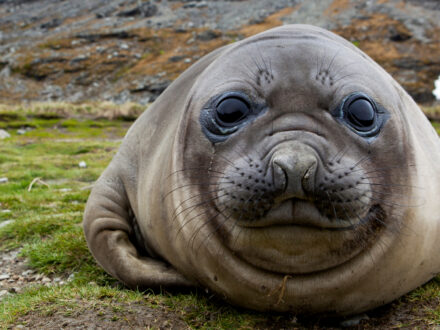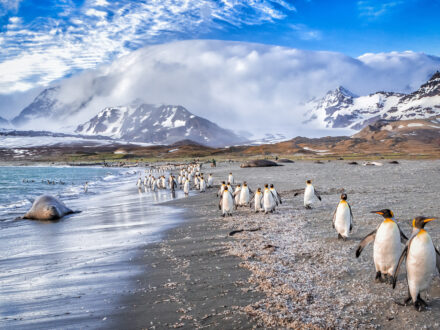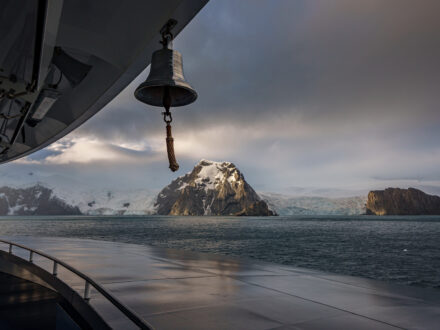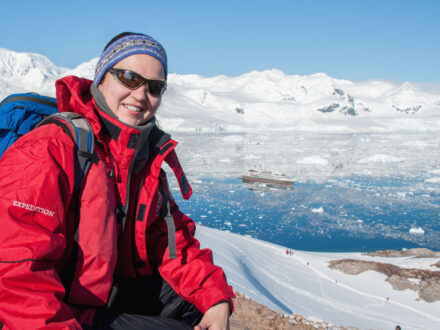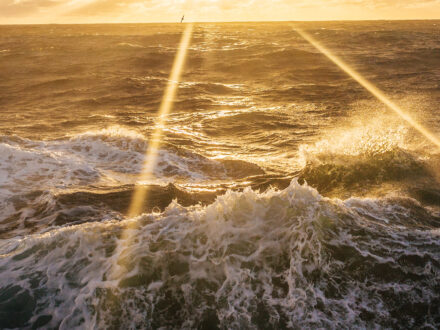Antarctica Cruise Routes: Which Itinerary is Best For You?
- Antarctica Itinerary Options
- Drake Passage Cruises
- Fly-Cruise Options
- Antarctica Peninsula Cruises
- Antarctic Circle Cruises
- Antarctica, South Georgia, and Falkland Islands Cruises
- Ross Sea & East Antarctica Cruises
- Weddell Sea Cruises
- Patagonia & Antarctica Cruises
- Choosing an Antarctica Cruise Itinerary: Some Things to Consider
- Combination Antarctica Itineraries
It wasn’t long ago that visiting Antarctica was one of the most demanding and restricted destinations in the world: a place hard to reach and hard to survive upon arrival, with limited options for getting around. These days, that’s not the case: The White Continent is an increasingly popular place to travel, and its many astonishments—from epic wildlife spectacles to the grandest, purest wilderness scenery on the planet—are yours to enjoy via any number of different Antarctica routes and tour packages.
In this guide, we’ll break down some of your main options for an Antarctica cruise itinerary, discuss factors to consider when choosing one or another, and also highlight some additional possibilities for seeing the bottom of the world in all its glory.
Antarctica Itinerary Options
The following itineraries cover much of the main tourist circuit in Antarctica. (We’ll touch on other kinds of tours, packages, and geographies later in this article.)
Drake Passage Cruises
The vast majority of people who travel to Antarctica do so by ship from South America, and most who do so embark from Ushuaia, Argentina. This means such travelers reach the White Continent by crossing the notorious Drake Passage, the 500-mile seaway forming the narrowest gap between the Antarctic and the more northerly Southern Hemisphere continents. It separates Cape Horn in Tierra del Fuego, the southernmost tip of South America, from the South Shetland Islands, on the doorstep of the White Continent just across the Brunsfield Strait from the Antarctic Peninsula.
These voyages land passengers honest-to-goodness bragging rights, as the Drake Passage ranks among history’s most fabled and infamous of maritime highways. Roiled by the powerful Antarctic Circumpolar Current and exposed to the unobstructed brunt of the westerly winds, the Drake is renowned for its rough seas and storminess.
But modern cruise vessels are well-equipped to deal with these conditions, navigating around or waiting out storms and offering overall a quite comfortable ride through riled-up waves. Drake Passage cruises often deliver sightings of exciting wildlife, including marine mammals, as well as the first glimpses of Antarctic icebergs rafting northward.
Fly-Cruise Options
Whether because they don’t want to endure potential seasickness crossing the Drake Passage, or because they want to dedicate as much time of their vacation as possible to Antarctica proper, some travelers choose to fly rather than sail to Antarctica. A flight from Punta Arenas, Chile to King George Island in the South Shetlands only takes a couple of hours, compared to the couple of days most ships take to sail across the Drake Passage. Those air travelers can then join cruise ships exploring the wonders of the Antarctic Peninsula.
An Antarctica fly-cruise can take one of two forms: fly/fly itineraries involving return flights to and from the South Shetlands, avoiding the Drake altogether; and fly/sail itineraries—which arguably get the best of both worlds experience-wise—involving flying between South America and Antarctica for one leg of the trip, and cruising across the Drake Passage for the other.
Antarctica Peninsula Cruises
Far and away the most popular place to visit on the White Continent is the Antarctic Peninsula, its northernmost extremity the ‘classic’ Antarctic destination. Just because it’s the most accessible (and most clement, relatively speaking) part of Antarctica doesn’t mean the Peninsula is any lesser taste of this polar wonderland. Indeed, the scenery of the Antarctic Peninsula ranks among the finest in the Antarctic, with formidable mountains towering over glaciers, ice shelves, beaches, fjords, and bays. And the wildlife-watching is as good as it gets in Antarctica, with huge colonies of penguins, seabirds, and seals on display, plus productive feeding grounds for baleen whales and orcas.
From the unreal-looking flooded caldera of Deception Island to the “Kodak Alley” bonanza of the Lemaire Channel, Antarctic Peninsula cruises show off some of the most iconic landmarks in the Antarctic region. And there’s so much to do: from outings by Zodiac or kayak to hikes along penguin beaches, cross-country skiing or snowshoeing beneath high peaks, and even bundled-up campouts under pristine skies.
Basecamp Itineraries
For those seeking maximal Antarctic adventure, arguably the most intrepid option is the popular and action-packed Basecamp itinerary. This Antarctic Peninsula-based trip includes more time on land than aboard your vessel compared to more traditional Antarctica cruises, and features numerous opportunities for kayaking, Zodiac-cruising, hiking, glacier-walking, snowshoeing, and mountaineering amid the ravishing and little-trammeled peaks of the Peninsula.
This is also a great choice for camping out in Antarctica, a rare accomplishment that’ll stay with you forever; among the potential campsites are spots along world-famous Paradise Bay and near Damoy Point.
Antarctic Circle Cruises
Ringing the White Continent at roughly 66 degrees S latitude, the Antarctic Circle forms the northern boundary of the true Antarctic zone, south of which the midnight sun defines summer and the polar night prevails in winter.
Antarctic Circle cruises generally begin in January, but departures become increasingly frequent in February and March when the seasonal contraction of sea ice makes the Antarctic Circle accessible to cruise vessels. A minority of travelers experience the thrill of crossing this historically rich line of latitude, and can enjoy relatively little-visited sights such as the upper Antarctic Peninsula’s Marguerite Bay and the remote, ice-wreathed Weddell and Ross seas.
Antarctica, South Georgia, and Falkland Islands Cruises
Those with the time and interest can combine some beautiful and fascinating subpolar islands on their journey to the Antarctic Peninsula. The so-called “FSG itinerary” weaves visits to the British Overseas Territories of the Falkland Islands (about 250 miles off the Patagonian coast of Argentina) and South Georgia (900 or so miles north of the tip of Antarctica) into Peninsula tours.
These islands serve up plenty of their own magic, including rich history—not least the Falklands War and Ernest Shackleton’s route across South Georgia to obtain rescue for his stranded, shipwrecked companions—and unbelievable wildlife. Indeed, South Georgia in particular, with its great seabird, penguin, and pinniped menageries, offers as thrilling wildlife safaris as the Antarctic Peninsula itself.
Ross Sea & East Antarctica Cruises
Few vacationers ever get to see the dreamworld that is the Ross Sea, lying well below the Antarctic Circle and separating the West Antarctic and East Antarctic ice sheets. Those who cruise here from Oceania can marvel at the biggest ice shelf on Planet Earth—the 190,000-square-mile Ross Ice Shelf, which brandishes a gigantic frozen scarp at its edges—and the southernmost active volcano: noble Mount Erebus, topping the fire-and-ice heights of Ross Island.
Ross Sea cruises from Australia or New Zealand also drink deeply of Antarctic history: Come ashore to visit the famous Scott and Shackleton huts, which look as though their iconic respective expedition crews just bid them adieu that morning.
Weddell Sea Cruises
On the opposite side of West Antarctica from the Ross Sea, the luxuriously lonely Weddell Sea is thought to boast the cleanest water of any sea in the world. Weddell Sea cruises take in the more obscure sights of the eastern coast of the Antarctic Peninsula and then the dazzlements of the Weddell’s northwestern reaches, which include behemothic tabular icebergs and dramatic sea-ice fronts.
The wildlife scene in the Weddell Sea is thrilling, too, with the northernmost colony of emperor penguins along Snow Hill Island as well as outstanding numbers of Adélie penguins, abundant baleen whales and orcas, and leopard, Weddell, crabeater, and other seals.
Patagonia & Antarctica Cruises
For those southbound explorers seekers the ultimate icebound expedition, cruising Patagonia provide an unforgettable prelude to Antarctica, an awe-inspiring journey through wild landscapes navigating the intricate maze of the Chilean fjords, where colossal glaciers tumble into secluded bays, jagged Andean peaks pierce the sky, and untouched forests blanket remote shorelines.
Sailing through storied waterways such as the Strait of Magellan and Beagle Channel, travelers may spot colonies of Magellanic penguins, soaring Andean condors, and breaching humpback whales. The windswept headland of Cape Horn, the last landmass before the vast Southern Ocean, signals the start of the polar portion of your epic Patagonia and Antarctica cruise route, as you cross the Drake and the wonders of the Antarctic Peninsula beckon.
Choosing an Antarctica Cruise Itinerary: Some Things to Consider
To narrow down which sort of Antarctica itinerary might best suit your needs and interests, here are some factors to consider.
Time/Expense
Antarctica is worth visiting even if you only have limited time, given the sheer specialness of the destination. Those who are operating on a restricted schedule might opt for a quick, short 5 day trip to Antarctica or a slightly longer 7-day itinerary that involves flying in and out rather than taking the time to sail, or at least flying for one leg of the journey.
But for most people, a mid-length 10-day to 14-day (or night) itinerary gives a good amount of time to explore the Antarctic Peninsula in depth, and maybe even allow enough time to cross the Antarctic Circle.
If you have a more ample window within which to travel, you might weigh an extended cruise of around 21-days, such as the FSG itinerary or even the once-in-a-lifetime semi-circumnavigation option of sailing between South America and New Zealand via the Antarctic Peninsula and Ross Sea.
Flying generally is more expensive than going by ship, and obviously traveling for longer to more remote destinations, or adding on special experiences such as scuba diving or scenic helicopter rides will accordingly cost more. (Get the lowdown on the cost of Antarctic cruises and tours here.)
Scenery
There really isn’t any dull scenery in Antarctica, per se: Even the utter blankness of the East Antarctic Ice Sheet is astonishing to see, given it’s about the harshest, most back-of-beyond swath of terra firma on the planet.
The Antarctic Peninsula is one of the most photogenic parts of the continent, while various continental mountain ranges, including the Ellsworth Mountains (highest in Antarctica) and the Transantarctic Mountains, are also breathtakingly beautiful, rewarding those who make the effort to include these farther-flung destinations. Expect amazing icebergs and ice-shelf sights in the Ross and Weddell seas.
Wildlife
The all-around best wildlife-watching in Antarctica awaits on the sub-Antarctic island of South Georgia. With 30 million breeding birds, including 7 million penguins and 250,000 albatrosses, this is the world’s most important penguin and seabird breeding area. But it isn’t just for bird-lovers; more than 2 million fur seals and 50% of the world’s southern elephant seals can be found here too! Indeed, at the height of the breeding season, there is said to be more wildlife per square foot here than in any other place on the planet!
If you don’t have the time or funds to visit South Georgia, don’t fret, as the Antarctic Peninsula—frequented by the more popular and shorter cruise itineraries—is also famed for its bird-and-sea-beast breeding colonies and its rich marine feeding grounds.
Wildlife tends to be thinner deeper into the Antarctic, but those who want to increase the odds of seeing the much-coveted emperor penguin—biggest of all penguins and the only warm-blooded creature besides humans to winter on the Antarctic ice sheets—should consider Weddell Sea or Ross Sea itineraries or specialized wildlife tours in the harsher southern realms.
History
Besides the scenic beauty, wildlife riches, and exhilarating remoteness, part of the appeal of an Antarctic cruise is the dramatic history. Following the routes of iconic explorers such as Ernest Shackleton, Robert Falcon Scott, James Cook, and Douglas Mawson provides its own singular thrill, and all the more so if you’re a dyed-in-the-wool history buff.
There’s plenty of history on display along such typical cruise circuits as South Georgia (drenched in whaling heritage and home to Shackleton’s grave) and the Antarctic Peninsula. That said, it’s hard to top the Ross Sea and its McMurdo Sound if—like so many—you’re borderline obsessive about the Heroic Age of Antarctic Exploration.
Immersiveness
Some of the larger cruise ships visiting the White Continent are restricted in how close and thoroughly they can explore the coastline of the Antarctic Peninsula, and offer mainly an offshore sightseeing experience. Those who wish to get a more firsthand sense of the polar wilds might consider cruises aboard smaller, more nimble expedition vessels, and/or adding on landfalling excursions such as hikes, camping, and ski tours.
And certainly the less-common tourist routes penetrating south of the Antarctic Circle, which ply basically empty waters, impart their own sense of deep immersion in the Antarctic.
Adventure
All things considered, any trip to Antarctica—even a luxury cruise spent entirely at sea—is a great adventure, given just where you’re traveling. But it’s easy to amp up the adventure with guided kayaking or stand-up paddleboarding tours, overnight campouts, mountain-climbing, and the like.
And there are plenty of itineraries, such as the Basecamp ones and the mountaineering treks out of White Desert and ALE camps, that are specifically aimed at adventurers.
Geography
While much of Antarctica is effectively off-limits to your average tourist, there’s still a remarkable breadth and variety of geography that can be explored across widely available White Continent itineraries. Some destinations, such as the South Pole itself, the Ellsworth Mountains, and the Weddell or Ross seas, necessarily demand specific packages or add-on experiences.
But bear in mind that the Antarctic Peninsula—truly a must-see place, even if it’s the most heavily visited—is included in many different kinds of Antarctica cruise routes, including those venturing much deeper into the Antarctic zone.
Combination Antarctica Itineraries
When selecting your dream Antarctica cruise itinerary, it’s important to understand that the Antarctica itinerary options highlighted above are by no means mutually exclusive, and there are polar route permutations and combinations aplenty. For example, almost all itineraries will visit the Antarctic Peninsula, so should you, say, opt for an Antarctic Circle cruise you will visit the peninsula and cruise a little further south to cross the circle.
Extending this concept further, you could even visit the peninsula, cross the circle and visit South Georgia and the Falklands for one of the most epic itineraries imaginable. Added to this, each itinerary typically gives you the option to either cross the Drake Passage or fly over it in one or both directions, so the variations are almost endless.
What’s more, many travelers to Antarctica—who have the time, of course—opt to incorporate pre- or post-cruise land-based tours of South America into their White Continent adventuring: A trip, for example, that combines sightseeing in Buenos Aires, the cascading waterfalls of Iguazu, or the wilds of Patagonia with an Antarctic cruise is about as bucket-list as they come!
Disclaimer
Our travel guides are for informational purposes only. While we aim to provide accurate and up-to-date information, Antarctica Cruises makes no representations as to the accuracy or completeness of any information in our guides or found by following any link on this site.
Antarctica Cruises cannot and will not accept responsibility for any omissions or inaccuracies, or for any consequences arising therefrom, including any losses, injuries, or damages resulting from the display or use of this information.










































